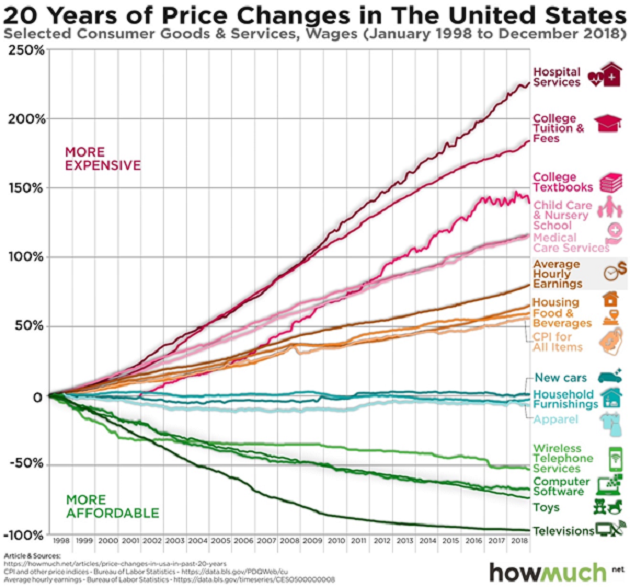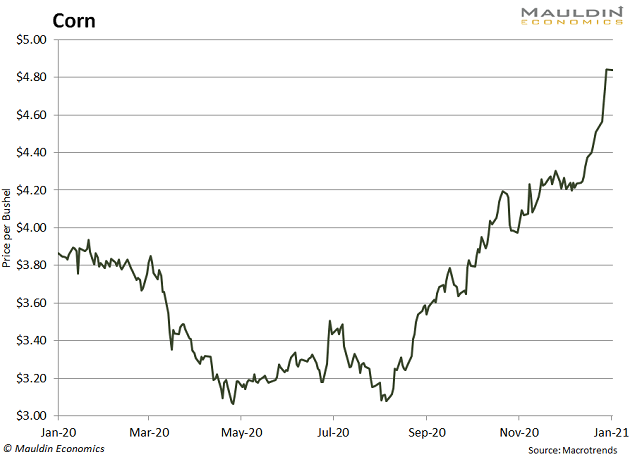| January 7, 2021 Hedonic Adjustments  My mom called me up the other day and asked for a TV for her birthday. She wants a small 24-inch TV that she can put next to the treadmill. I haven’t shopped for a TV in a few years. I was thinking to myself that this would be a $300 gift. Then my mom tells me that you can get 24-inch TVs for $99. Ninety-nine bucks for a TV. I am not sure who is making money off a $99 TV. That’s incredible. And that’s the miracle of capitalism in action… | | | | | - | Talk to Jared Dillian and Ask Your Financial Questions  | Should you pay off your mortgage or put the money into interest-bearing investments? How much debt is too much debt? And how do you save and invest to become a millionaire by the time you retire? Listen to Jared’s syndicated radio show and ask him your personal-finance questions or discuss the economy and markets with him. |
Listen live Monday–Friday from 6–8 pm Eastern.
And call 1-844-305-7800 to talk to Jared in person. He would love to hear from you! | | | | | |
|
If the government stays out of the way and does not regulate the manufacture of TVs, prices will decline over time. I remember when I was a kid, there was a TV store in the mall. It was right by the front entrance. You could get a big tube TV, one of those wooden ones by Zenith, for $600—$600 in 1983 dollars, versus $99 in 2021 dollars. Absolutely amazing. In real terms, the price of a TV has declined by over 90%. The Bureau of Labor Statistics says that it has declined by more than that. BLS does this thing called hedonic adjustments. That's where the inflation bean counters take into account the quality differences in a TV as well as the price. Not only has the price gone down, but the quality has improved. According to the BLS, that means the price has gone down even more. This is one way in which we systematically undercount inflation. There are other ways, but this is the biggest, at least when you’re talking about the Consumer Price Index (CPI). Critics of hedonic adjustments say that you still have to buy a TV and you’re not getting it for 99% off. A TV is a TV. Of course, TVs are an example where prices have declined over the years. In healthcare and education, prices have risen, proportional to the amount of government involvement. Years ago, there was a chart going around that showed how the prices of certain goods and services had trended over the past few decades. 
Source: HowMuch In places where entrepreneurs were free to innovate, prices declined the most. It’s Complicated Inflation is very complicated. Most macro thinkers, like I suspect you might be, look at inflation in purely monetarist terms: the supply of money and the increased supply of dollars chasing the same amount of goods. It’s said that 35% of all dollars in existence were created in the past 10 months. Common sense would tell you that would cause inflation. Left-wingers, generally speaking, look at the current level of inflation, which is about 2%, and say that the relationship between money supply and inflation has broken down. Milton Friedman was wrong. Maybe not—where would inflation be in the absence of all the printing? A pandemic is supposed to be a deflationary shock. We’re actually supposed to be experiencing deflation right now, but we’re not. People have saved quite a bit of money during the pandemic. Once it’s over, and people begin spending again, inflation is likely to rise. But maybe not! Technological improvements result in falling prices, but so do demographics. As the population ages, we can expect inflation to fall even further. I like to say inflation is mostly psychological: If people expect price increases, then they will change their economic behavior accordingly. They will buy more things faster, which will cause more price increases. If people expect price declines, they will delay their purchases. It is difficult to arrest a trend in inflation or deflation once it is in motion. But Have You Seen Commodities? Check out this chart of corn prices, for example:  This looks like a lot of commodity charts out there right now, going from the lower left to the upper right, whether it’s agriculture, energy, metals, or soft commodities. By the way, the next time you are in the grocery store, take a look around—pretty much half the goods in the store are made of corn. Of course, in the context of a long-term chart in commodities, what we experienced in 2020 is just a blip:  Which leads me to believe that commodity prices have a lot further to run. I am bullish on inflation, though I acknowledge that people have been bullish on inflation since the first round of QE back in 2008, and it’s never materialized. This time, however, it’s not coming from the monetary side… it’s coming from the fiscal side. We’ve handed out a lot of money in the last year: PPP loans, enhanced unemployment benefits, and stimulus checks. Sooner or later, this is going to find its way into the economy… right about the time that states start to ease their pandemic restrictions. This is independent of whatever the Fed does or doesn’t do. The charts are already moving—by the time it shows up in the official statistics, it will be too late. There’s no need to run out and buy 20 bags of fertilizer at the moment, and I certainly hope that isn’t in our future. Either way, stay tuned and I'll show you how to play it. 
Jared Dillian  ETF 20/20: Your solution for intelligent ETF investing. Jared’s introductory service, helps investors use ETFs to make more money in the markets with less volatility. ETF 20/20 is a newsletter for every investor—order your subscription now | | Other publications by Jared Dillian: Street Freak: Jared’s monthly newsletter for self-directed stock pickers. Learn how to pick and trade trends, and master your inner instincts here. The Daily Dirtnap: Want to read Jared every day of the week? Hear his daily thoughts on the markets, investor sentiment, central banks, and a dose of dark wit. Thousands of sophisticated investors, Wall Street traders, and market participants read Jared’s premier service, The Daily Dirtnap. Get it here. |
Share Your Thoughts on This Article
  Was this email forwarded to you?
Click here to get your own free subscription to The 10th Man.
Read important disclosures here.
YOUR USE OF THESE MATERIALS IS SUBJECT TO THE TERMS OF THESE DISCLOSURES. | 